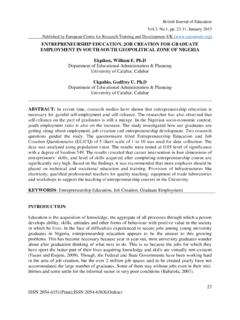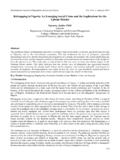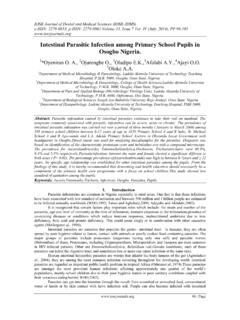Transcription of Incidence of Complications after Central ... - IOSR Journals
1 IOSR journal of Dental and Medical Sciences (IOSR-JDMS) e-ISSN: 2279-0853, p-ISSN: 14, Issue 5 Ver. II (May. 2015), PP 45-48 DOI: 45 | Page Incidence of Complications after Central Venous Cannulation- A Prospective Observational Study Dr. Sara Korula1, Dr. Vergis Paul 2. Department of Anesthesiology and Critical Care, MOSC Medical College, Department of Surgery, MOSC Medical College, Kolenchery, Abstract: Background and aim: The use of Central venous catheters or Central lines has developed into an essential element of medical practice in critical care, anaesthesia and emergency medicine as well as for long-term therapies such as chemotherapy or dialysis.
2 As with all invasive procedures Central venous cannulation also is associated with multiple Complications . The aim of our study was to determine the Incidence of Complications after Central venous catheter insertion in a rural tertiary care teaching hospital in south India Methods: The study was a prospective observational study conducted in a rural tertiary care center, for a period of 6 months (August 1ST, 2014 to January 31ST, 2015) . We collected data from 50 patients in whom landmark-based Central venous cannulation using Seldinger technique was performed during this period.
3 Complications were classified as immediate Complications , which occurred at the time of Central line insertion and delayed Complications as that which occurred during the time the Central line was insitu. The data was tabulated and analyzed using SPSS Continuous data was expressed as mean Standard Deviation. Categorical data was expressed as percentages. Results: The mean age of the patients in the study sample was 52% of patients were male. The average number of days for which the Central line maintained was The immediate Complications that occurred were arterial puncture(10%) , bleeding (4%) and arrhythmia (16%).
4 The main delayed complication of Central venous cannulation was occlusion of the lumens of the catheter (22%). One patient had thrombosis of the vein. There was only one Incidence of catheter tip infection. Conclusion: This study shows that the commonest Complications of Central line insertion are arterial puncture and arrhythmia during insertion of the Central venous catheter. We recommend the routine use of an ECG monitor and ultrasound guidance or pressure transducer during Central venous cannulation to minimize the Incidence of these Complications Keywords: Central Venous Cannulation, Arterial Puncture, Catheter Occlusion, Complications .
5 I. Introduction The history of Central venous cannulation starts in 1929 when Forssmann described the advance of a plastic tube to the heart by puncturing his own arm vein. At the beginning of the 1950s Aubaniac reported about the puncture of the subclavian technique described in 1953 revolutionized the field of bedside procedures especially Central venous cannulation(1). The use of Central venous catheters or Central lines has developed into an essential element of medical practice in critical care, anaesthesia and emergency medicine as well as for long-term therapies such as chemotherapy or dialysis.
6 (2) Three Central veins are typically used for venous access: the internal jugular vein (IJ), subclavian vein, and femoral vein. The common Complications of the procedure are arterial puncture leading to hematoma, pneumothorax, infection and thrombosis and the relative contraindications for Central line insertion are coagulopathy and infection at the site of insertion. The benefits of a Central line over peripheral access include greater longevity without infection, line security in situ, avoidance of phlebitis, larger lumens and multiple lumens for rapid administration of combinations of drugs, a route for nutritional support, fluid administration, and Central venous pressure monitoring.
7 The aim of our study was to determine the Incidence of Complications after Central venous catheter insertion in a rural tertiary care teaching hospital in south India. II. Materials And Methods The study was a prospective observational study conducted in a rural tertiary care centre, for a period of 6 months (August 1ST, 2014 to January 31ST, 2015) . We collected data from 50 patients in whom landmark-based Central venouscannulation using Seldinger technique was performed during this period. Central venous catheterization in three different sites internal Jugular Vein, SubclavianVein and Femoral vein in were analyzed.
8 We recorded baseline data for each patient , co morbidities of the patient , site Incidence of Complications after Central Venous Cannulation- A Prospective Observational Study DOI: 46 | Page of Central line and where the patient was admitted for further care. The indication for the insertion and removal of Central line was noted. Complications were classified as immediate Complications , which occurred at the time of Central line insertion and delayed Complications as that which occurred during the time the Central line was insitu. A diagnosis of catheter related blood stream infection was made if patient had sepsis with positive culture reports of Central line tip culture.
9 The data was tabulated and analyzed using SPSS Continuous data was expressed as mean Standard Deviation. Categorical data was expressed as percentages. III. Results A total of 50 patients were enrolled in the study over a period of 6 months. The mean age of the patients in the study sample was 52% of patients were male. Out of 50 patients, 30 Central venous catheters (CVC) were inserted in ICU (60%) and 20 CVC were inserted in OT (40%) . 45 patients were admitted in ICU (90%) and 5 were admitted in ward (10%) after insertion of CVC. 26% of these patients required mechanical ventilation.
10 The average number of days for which the Central line maintained was Table 1 : Site Of Central Line Table 2: Indication For Insertion Of Central Line Indication Frequency Percent CVP 2 FLUID THERAPY 31 TPN 5 VASOPRESSORS 12 Total 50 Of the 50 patients, maximum number (62%)of Central lines were inserted for intravenous administration of fluids and drugs especially intraoperatively. Two catheters were inserted for Central Venous Pressure (CVP) measurement (4%), 5 catheters were inserted for giving Total Parenteral Nutrition (TPN) (10%) and 12 Central venous catheters were inserted for giving vasopressor(24%) therapy.














